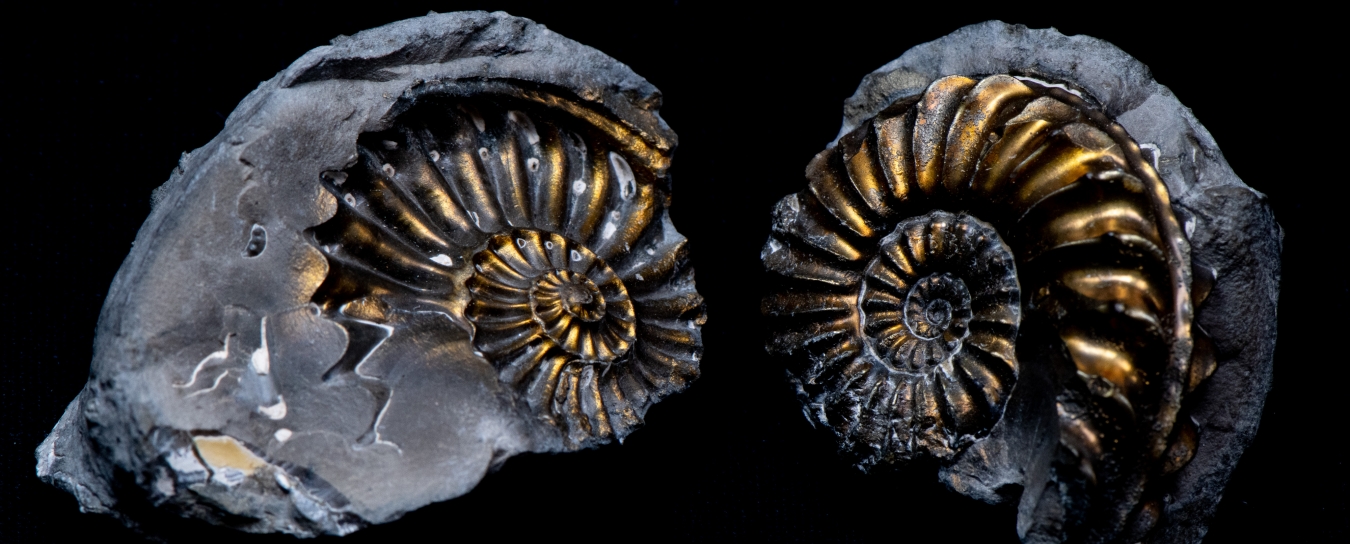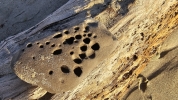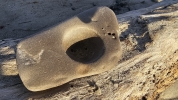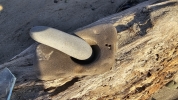
Rocks & Fossils
Check out our rock and fossil FAQ for smart collecting tips, information about some local rock formations, and advice about fossil eggs and meteorites.
- Anthropology
- Rocks & Fossils
- Invertebrates
- Vertebrates
- Botany
- Astronomy
- Fungi
- General
- Recently Asked
Mortar rock found on Santa Barbara beach after Hurricane
Hi, I found this rock on the beach in Santa Barbara a few days after Hurricane Hilary. Just wondeting if this in an authentic artifact? Thanks, Mike



Curator Response
Dear Mike,
Thanks for sending in your photos of this interesting rock. It looks like a classic piece of Monterey Shale (from the famous local Monterey Formation). We see no signs of human modification.
Based on your photos, the holes are consistent with boring bivalves: clams and mussels with unique adaptations that allow them to bore holes in relatively soft rocks, thereby gaining protection from predators. We’ve shared more information about boring clams in the answer to a previous question.
The side showing many small boreholes is likely showing traces of a boring mussel, perhaps in the genus Leiosolenus, and likely the species Leiosolenus plumula. They are pretty common in Monterey Shale. The larger single hole on the other side is likely from a piddock (a kind of clam), either Parapholas or Penitella. Both of these genera have large species that could make a hole like the big one that appeared to you like a Chumash-style mortar.
We should note that even the smaller boring bivalve holes can get naturally worn larger by the scouring of sand in the current. This would be an instance of weathering: what happens when rocks are exposed to rain, snow, sun, waves, etc.
We get lots of questions from people about interestingly weathered rocks that resemble fossils or artifacts. In our experience, groundstone is probably the most mis-identified artifact class here, because so many natural objects look similar. Out of the thousands of mortars recovered, none are so asymmetrical between inner and outer surfaces as your bivalve-bored rock. Were it really a mortar, such a large, flat top surface/rim would retain more evidence of manufacture along the shoulder of the large depression. Since we have many examples of these clam-bored rocks, as well as mortars, we learn to recognize each fairly quickly. It takes a trained eye to spot the difference, and hopefully we have now trained your eye a little bit more.
Your rock shows such a cool combination of features that we would like to ask your permission to use it on our Handy Rock & Fossil Facts page at sbnature.org/geoFAQ. You can let us know your response below.
Stay curious,
Associate Curator of Anthropology Brian Barbier, M.A.; Curator Emeritus of Malacology Paul Valentich-Scott, Dibblee Curator of Earth Science Jonathan Hoffman, Ph.D.


